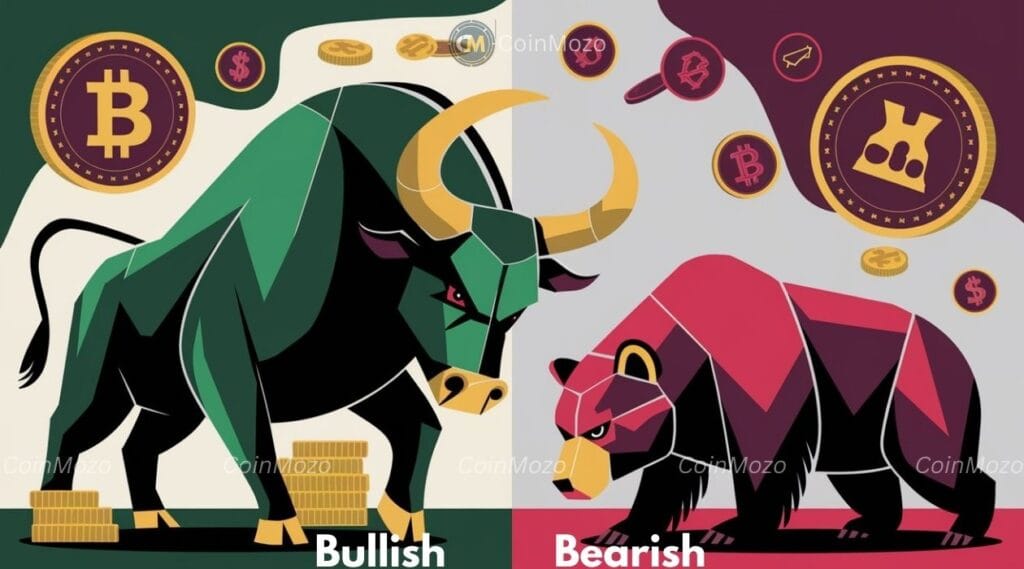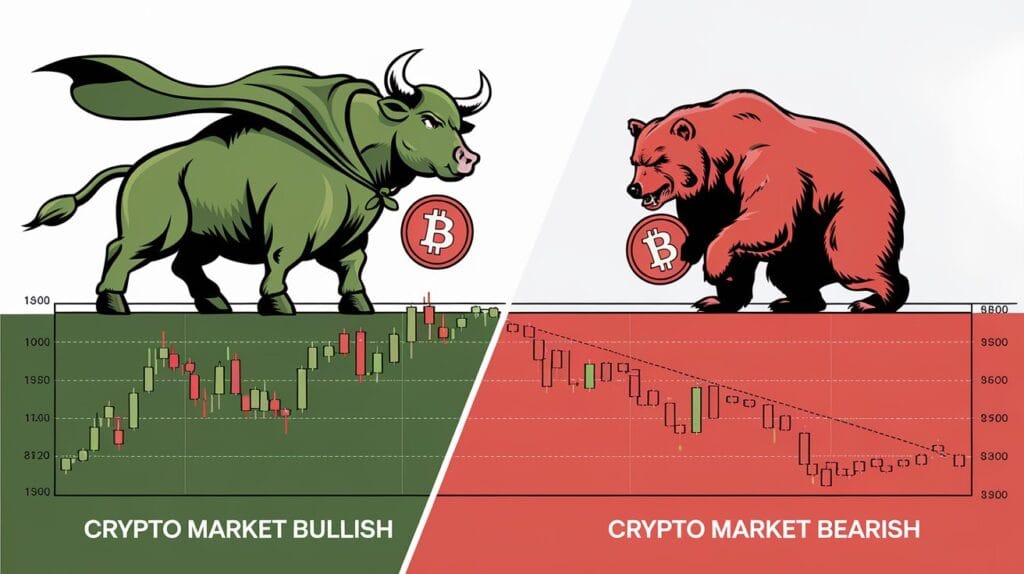Bullish and bearish are terms used to describe market sentiment in crypto. A bullish market means investors are optimistic, causing prices to rise. A bearish market means investors are desperate, leading to falling prices.
In cryptocurrency, market trends shift between two forces: bullish and bearish. These terms describe the market’s direction and investor mood. A bullish market happens when prices rise and investors are optimistic. A bearish market occurs when prices fall and investors are pessimistic.
This article explains market sentiment and how these trends impact investment decisions.
Key Takeaways
- Bullish in crypto means investors are optimistic, and prices are rising.
- Bearish in crypto means investors are pessimistic, and prices are falling.
- Bullish markets are driven by positive sentiment, rising prices, and increased trading.
- Bearish markets are marked by negative sentiment, falling prices, and cautious investors.
- Recognizing these trends helps traders make smarter investment decisions.
- In a bullish market, traders may buy low and sell high; in a bearish market, traders might hold or buy at lower prices.
- Market sentiment is influenced by news, events, and investor emotions.

What Is Bullish and Bearish in Crypto?
In the simplest terms, bullish and bearish are used to describe the overall direction of the market. These terms are used widely in the financial world, especially in cryptocurrency trading, to indicate how investors feel about the future of a particular asset.
- Bullish refers to a market sentiment where investors are optimistic, and the price of a cryptocurrency is expected to rise. If the market is bullish, people believe that the value of the cryptocurrency will increase shortly.
- Bearish refers to the opposite sentiment: when investors are pessimistic, the price of a cryptocurrency is expected to fall. In a bearish market, people believe that the value of the cryptocurrency will decrease.
These terms are a reflection of how investors feel about a particular cryptocurrency or the market in general. They are not just based on numbers but also on investor psychology, news, events, and external factors affecting the cryptocurrency world.
Bullish vs Bearish: Fundamental Differences in Crypto
Bullish Market in Crypto: A bullish market is one where investors are optimistic about the future of a cryptocurrency. In a bullish market, prices generally rise as more people buy into the asset, believing its value will increase over time. This optimism can be driven by positive news, strong market demand, or overall confidence in the asset’s future. During a bull market, traders may experience what’s known as a “bull run,” where prices surge quickly and significantly.
Bearish Market in Crypto: In contrast, a bearish market reflects desperation, where investors expect prices to fall. During a bearish market, people may sell off their assets, fearing that prices will continue to decline. This can lead to a “bear market,” where the overall sentiment is negative, and cryptocurrencies lose value. Bearish trends often occur when there’s bad news, economic uncertainty, or fear about the future of the market.
Key Differences:
- Market Sentiment:
- Bullish: Optimistic, prices rising.
- Bearish: Pessimistic, prices falling.
- Investor Behavior:
- Bullish: Investors buy and hold, anticipating higher future prices.
- Bearish: Investors sell off their holdings to minimize losses.
- Price Movement:
- Bullish: Prices increase.
- Bearish: Prices decrease.
Understanding these fundamental differences helps investors determine how the market might behave and decide when to buy, hold, or sell their crypto assets.
How to Spot a Bullish Market in Crypto
Understanding bullish and bearish trends in crypto is key to making smart investment choices. In a bullish crypto market, several signs indicate that prices are likely rising:
Rising Prices: The most obvious sign of a bullish market is a consistent increase in the price of a cryptocurrency over time.
Increased Trading Volume: A bullish market often has higher trading volume, meaning more people are buying and selling the cryptocurrency, showing confidence in the market.
Positive News and Events: Positive news, like big companies investing in crypto or new tech updates, can signal a bullish market. These events excite investors and push prices higher.
Investor Sentiment: When investors feel optimistic about a cryptocurrency’s future and talk positively about it, the market is likely bullish.
How to Spot a Bearish Market in Crypto
A bearish market in cryptocurrency is marked by falling prices and negative sentiment. Here are some signs that the market may be bearish:
Falling Prices: The most obvious sign of a bearish market is a steady decline in the price of a cryptocurrency.
Decreased Trading Volume: In a bearish market, trading volume tends to drop as investors lose confidence. Fewer people are buying or selling, showing hesitation in the market.
Negative News and Events: Bad news, such as government regulations, security issues, or problems with major cryptocurrencies, can trigger a bearish market. These events often lead to more people selling their assets out of fear, driving prices lower.
Investor Sentiment: In a bearish market, investors are often uncertain or pessimistic about the future. If there’s widespread fear or doubt, the market is likely bearish.
To learn more about Bullish and Bearish and other cryptocurrencies, follow CoinMozo on X
Examples of Bullish and Bearish Trends
Over time, the crypto market has seen many bullish and bearish trends. Here are two real-life examples:
Bullish Trend Example: In late 2017, Bitcoin saw a huge price surge. It went from around $1,000 at the start of the year to nearly $20,000 by December. This was driven by growing interest and adoption, especially from institutional investors. The bullish trend continued into early 2018, with the total market value of all cryptocurrencies hitting an all-time high.
Bearish Trend Example: A well-known example of a bearish trend happened with Ethereum in 2018. From January to December, Ethereum’s price fell from about $1,400 to $85. This drop was due to factors like a market downturn, scalability concerns, and more competition. Since then, Ethereum has recovered, helped by upgrades like Ethereum 2.0, which increased interest and adoption.

Why Do Markets Go Bullish or Bearish?
Crypto prices change a lot. Many things can make them go up or down. Here are some reasons:
External Factors: Things outside crypto, like the economy or government rules, can affect prices. Good news can make prices go up, bad news can make them go down.
Market Sentiment: The mood of investors drives the market. When investors feel confident and optimistic, they buy more crypto, causing a bullish market. On the other hand, fear, uncertainty, or doubt can lead to panic selling, creating a bearish market.
Technological Developments: Advances in blockchain technology or new uses for crypto can spark a bullish trend. However, technical issues, delays, or failures can contribute to a bearish trend.
Market Manipulation: Large investors, called “whales,” can influence the market. If they sell off large amounts of cryptocurrency, it can lead to a bearish market. But if they start buying, it can cause a bullish trend.
These factors, along with many others, can cause the market to shift between bullish and bearish trends. Understanding these drivers helps investors make better decisions.
What to Do During a Bullish or Bearish Market?
Understanding bullish and bearish trends in crypto helps traders make better decisions during both market conditions. Here’s what traders can do in each type of market:
In a Bullish Market:
1. Take Advantage of Rising Prices: In a bullish market, traders can buy crypto at lower prices and sell when prices go up. Traders can also hold if they expect the price to keep rising.
2. Stay Calm and Don’t Get Greedy: It’s tempting to chase big profits but avoid being too greedy. Prices can change quickly, and markets can be unpredictable.
3. Diversify Traders Portfolio: A bullish market can lead to higher risks. To manage risk, diversify their investments.
In a Bearish Market
1. Buy the Dip: A bearish market can offer opportunities to buy cryptocurrencies at lower prices. If traders believe in the long-term potential, this might be a good time to buy.
2. Consider Holding: If traders have already invested and the market is bearish, holding your assets until the market recovers could be a good choice.
3. Stay Calm and Avoid Panic Selling: Don’t panic and sell traders assets during a bearish market. Markets are cyclical, and prices often rise again after a decline.
By staying calm and making smart decisions, traders can navigate both bullish and bearish markets more effectively.
Conclusion: Market sentiment is the metaverse of the crypto space. A bullish market is characterized by rising prices and investor optimism, while a bearish market is defined by falling prices with cautioned investors. Understanding these trends helps in making better investment decisions.
A bullish market, where they buy at the bottom and sell at the top. In a bear market, they could be holding or may even buy for long-term gain strength. The trick is to stay up-to-date, spread risks, stay calm, and not use emotions to invest.
Knowing the signs of a bullish or bearish market allows traders to enhance their investment strategy and be ready for long-term crypto success.
Also Read: What Is Crypto Cold Storage? The Safest Ways to Secure Investor’s Crypto
